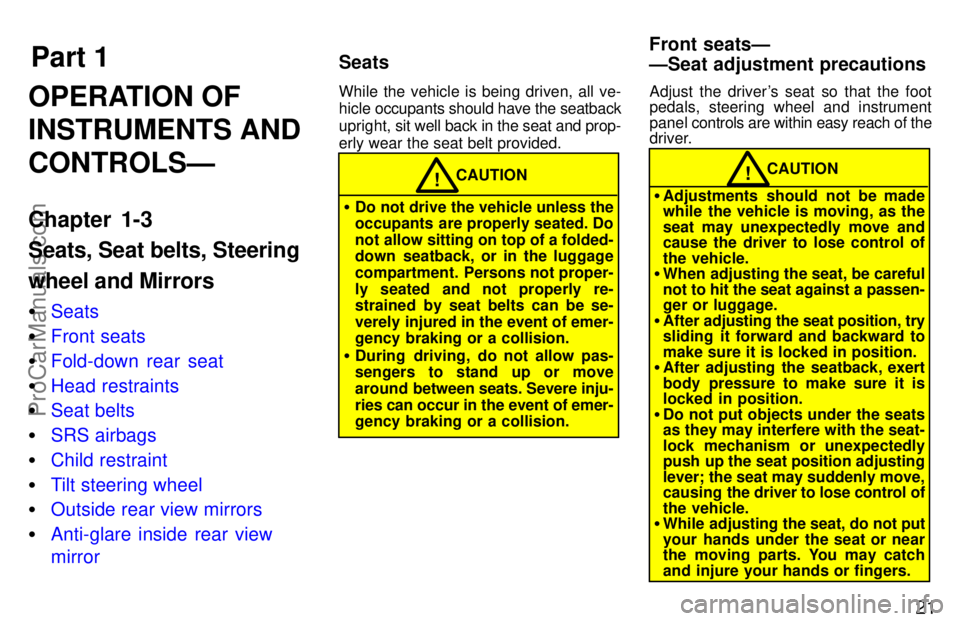Page 6 of 218
Part 1
1
OPERATION OF
INSTRUMENTS
AND CONTROLSÐ
Chapter 1-1
Overview of instruments
and controls
�Instrument panel overview
� Instrument cluster overview
� Indicator symbols on the
instrument panel
ProCarManuals.com
Page 7 of 218
2
1. Side vent
2. Side defroster outlet
3. Instrument cluster
4. Personal lights
5. Electric moon roof switches and interior lights
6. Glovebox
7. Power window switch and power door lock switch
8. Ashtray
9. Cup holder
10. Parking brake lever 11. Manual transmission gear shift lever or automatic transmission
selector lever
12. Lower vent
13. Hood lock release lever
14. Power window switches and power door lock switch
15. Power rear view mirror control switch (with power windows)
Instrument panel overview
ProCarManuals.com
Page 8 of 218
3
1. Headlight and turn signal switch
2. Wiper and washer switches
3. Emergency flasher switch
4. Clock
5. Center vents
6. Car audio
7. Miscellany box
8. Air conditioning controls
9. Rear window and outside rear viewmirror defoggers switch
10. Coupe and liftbackÐ Power rear view mirror control
switch (without power windows)
ConvertibleÐ
Convertible top control switch and
quarter window control switches
11. Cigarette lighter
12. Ignition switch
13. Cruise control switch
14. Tilt steering lock release lever
15. Instrument panel light control knob
ProCarManuals.com
Page 10 of 218
5
Anti-lock brake system warning light *1
Brake system warning light *1
Seat belt reminder light*1
Discharge warning light*1
Low oil pressure warning light*1
Malfunction indicator light*1
Low fuel level warning light *1
Open door warning light*1
SRS airbag warning light*1
Turn signal indicator lights
Headlight high beam indicator light
Over-drive indicator light
Cruise control indicator light*2
*1: For details, see Service reminder indicators and warning
buzzersº in Chapter 1-5.
*
2: If this light flashes, see Cruise controlº in Chapter 1-6.
Indicator symbols on the instrument panel
ProCarManuals.com
Page 25 of 218

Part 1SeatsFront seatsÐ
ÐSeat adjustment precautions
21
OPERATION OF
INSTRUMENTS AND
CONTROLSÐ
Chapter 1-3
Seats, Seat belts, Steering
wheel and Mirrors
�Seats
� Front seats
� Fold-down rear seat
� Head restraints
� Seat belts
� SRS airbags
� Child restraint
� Tilt steering wheel
� Outside rear view mirrors
� Anti-glare inside rear view
mirror
While the vehicle is being driven, all ve-
hicle occupants should have the seatback
upright, sit well back in the seat and prop-
erly wear the seat belt provided.
CAUTION!
� Do not drive the vehicle unless the
occupants are properly seated. Do
not allow sitting on top of a folded-
down seatback, or in the luggage
compartment. Persons not proper-
ly seated and not properly re-
strained by seat belts can be se-
verely injured in the event of emer-
gency braking or a collision.
� During driving, do not allow pas-
sengers to stand up or move
around between seats. Severe inju-
ries can occur in the event of emer-
gency braking or a collision. Adjust the driver's seat so that the foot
pedals, steering wheel and instrument
panel
controls are within easy reach of the
driver.
CAUTION!
� Adjustments should not be made
while the vehicle is moving, as the
seat may unexpectedly move and
cause the driver to lose control of
the vehicle.
� When adjusting the seat, be careful
not to hit the seat against a passen-
ger or luggage.
� After adjusting the seat position, try
sliding it forward and backward to
make sure it is locked in position.
� After adjusting the seatback, exert
body pressure to make sure it is
locked in position.
� Do not put objects under the seats
as they may interfere with the seat-
lock mechanism or unexpectedly
push up the seat position adjusting
lever; the seat may suddenly move,
causing the driver to lose control of
the vehicle.
� While adjusting the seat, do not put
your hands under the seat or near
the moving parts. You may catch
and injure your hands or fingers.
ProCarManuals.com
Page 56 of 218

Part 1Headlights and turn signals51
OPERATION OF
INSTRUMENTS AND
CONTROLSÐ
Chapter 1-4
Lights, Wipers
and Defogger
�Headlights and turn signals
� Emergency flashers
� Instrument panel light control
� Front fog lights
� Interior lights
� Personal lights
� Ignition switch light
� Luggage compartment light
� Windshield wipers and washer
� Rear window wiper and washer
� Rear window defogger
HEADLIGHTS
To turn on the following lights: Twist
the headlight/turn signal lever knob.
Position 1ÐParking, tail, license plate,
side marker and instrument panel lights
Position 2ÐHeadlights and all of the
above
The lights automatically turn off when the
driver's door is opened with the ignition
turned off. To turn them on again, turn the
key to the ONº position or actuate the
headlight switch. If you are going to park
for over one week, make sure the head-
light switch is off.
NOTICE
To prevent the battery from being discharged, do not leave the lights
on for a long period when theengine is not running.
Daytime running light system (Canada
only)
The headlights turn on when the parking
brake is released with the engine started,
even with the light switch in the OFFº
position. They will not go off until the igni-
tion switch is turned off.
To turn on the other exterior lights and in-
strument panel lights, twist the knob to the
position 1.
Under the daytime running light system,
the headlights turn on at reduced intensi-
ty. Twist the knob to the position 2 to turn
to full intensity for driving at night.
ProCarManuals.com
Page 57 of 218

52
High-low beamsÐFor high beams, turn
the headlights on and push the lever away
from you (position 1). Pull the lever to-
ward you (position 2) for low beams.
The headlight high beam indicator light
(blue light) on the instrument panel will tell
you that the high beams are on.
Flashing the high beam headlights
(position 3)ÐPull the lever all the way
back. The high beam headlights turn off
when you release the lever.
You can flash the high beam headlights
with the knob turned to OFFº.TURN SIGNAL
To signal a turn, push the headlight/
turn signal lever up or down to posi-
tion 1.
The key must be in the ONº position.
The lever automatically returns after you
make a turn, but you may have to return
it by hand after you change lanes.
To signal a lane change, move the lever
up or down to the pressure point (position
2) and hold it.
If the turn signal indicator lights (green
lights) on the instrument panel flash faster
than normal, a front or rear turn signal bulb
is burned out.To turn on the emergency flashers,
push the switch.
All the turn signal lights will flash. To turn
them off, push the switch once again.
Turn on the emergency flashers to warn
other drivers if your vehicle must be
stopped where it might be a traf fic hazard.
Always pull as far off the road as possible.
The turn signal light switch will not work
when the emergency flashers are operat-
ing.
Emergency flashers
ProCarManuals.com
Page 58 of 218
53
NOTICE
To prevent the battery from being discharged, do not leave the lights
on for a long period when theengine is not running.
To adjust the brightness of the instru-
ment panel lights, turn the knob.To turn on the front fog lights, twist the
band of the headlight and turn signal
switch lever. They will come on when
the tail lights are turned on.
Instrument panel light control Front fog lights
ProCarManuals.com